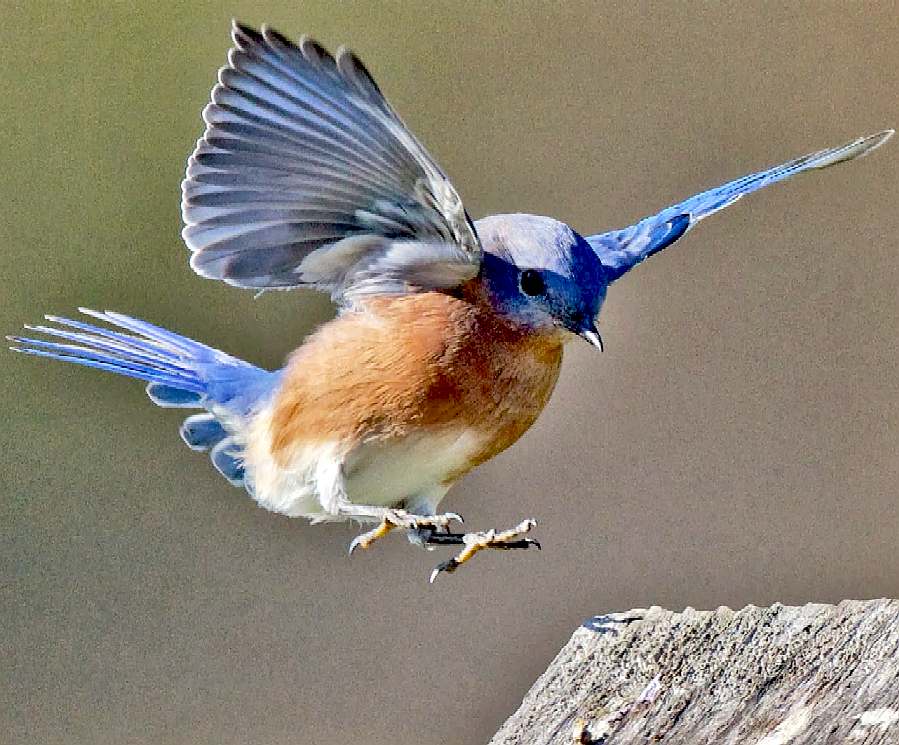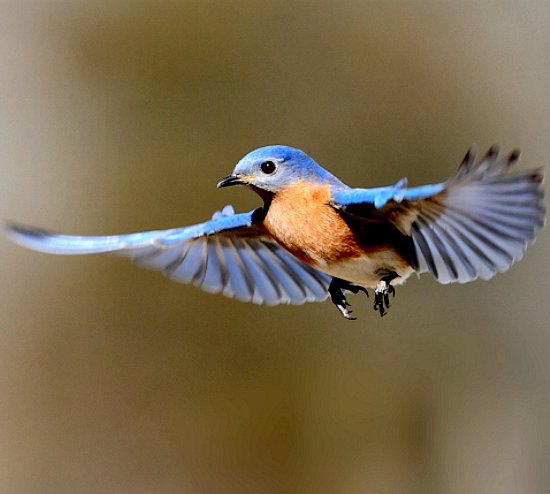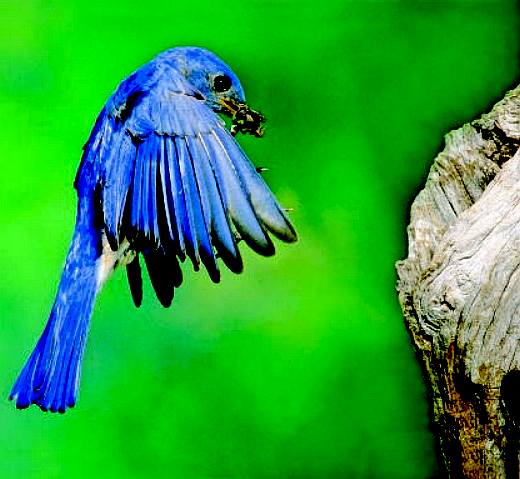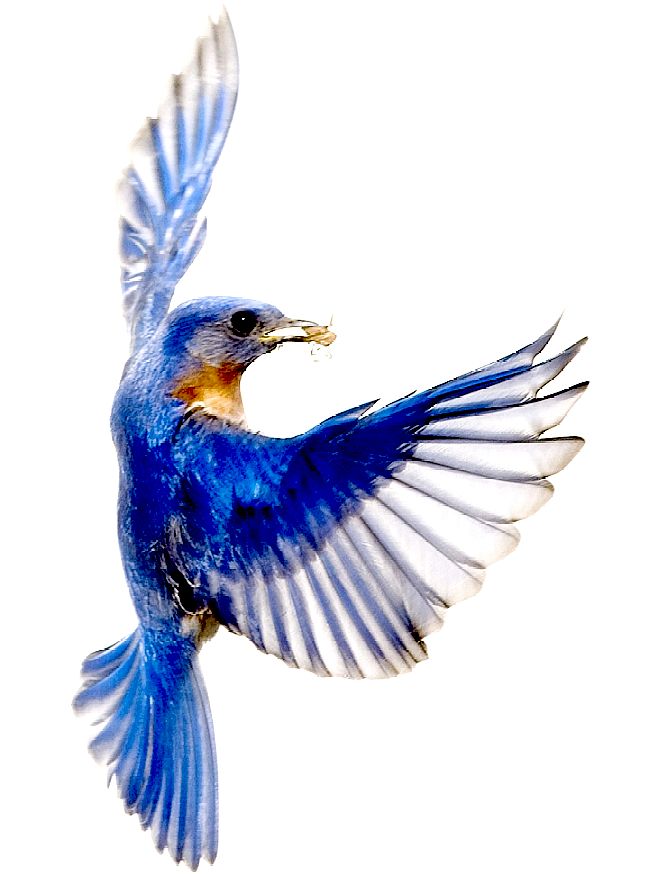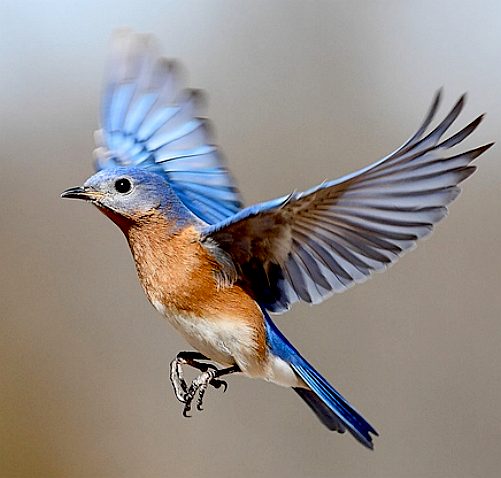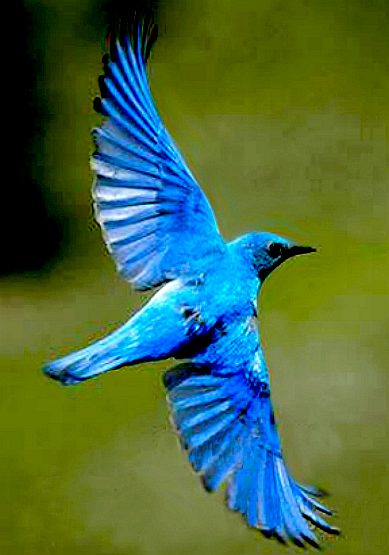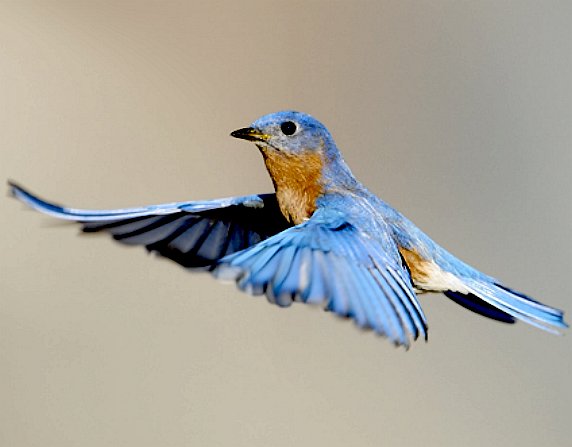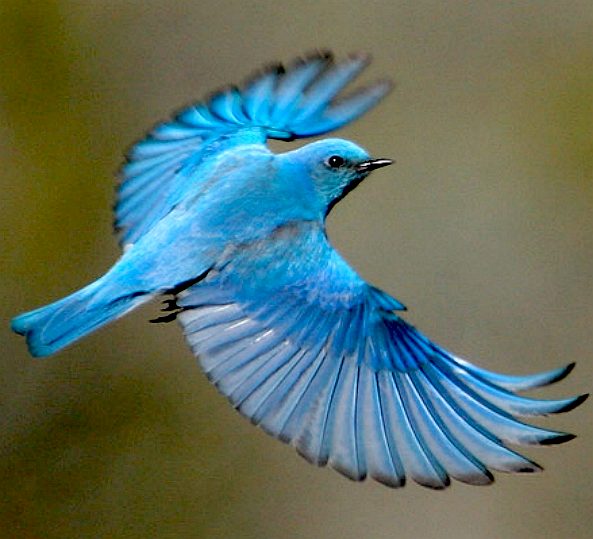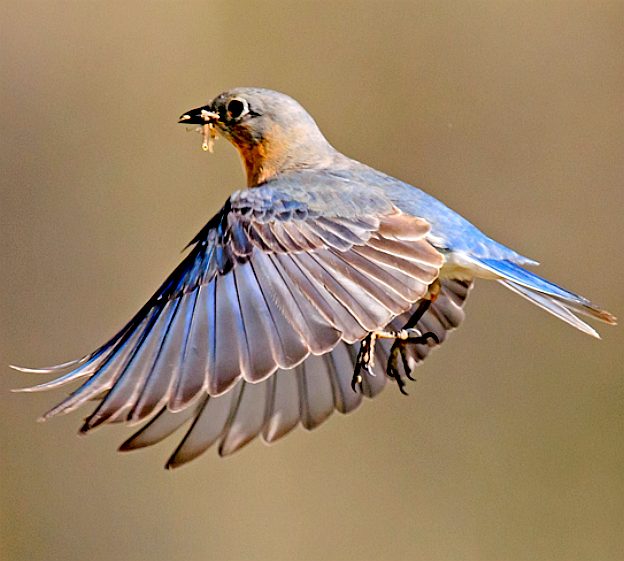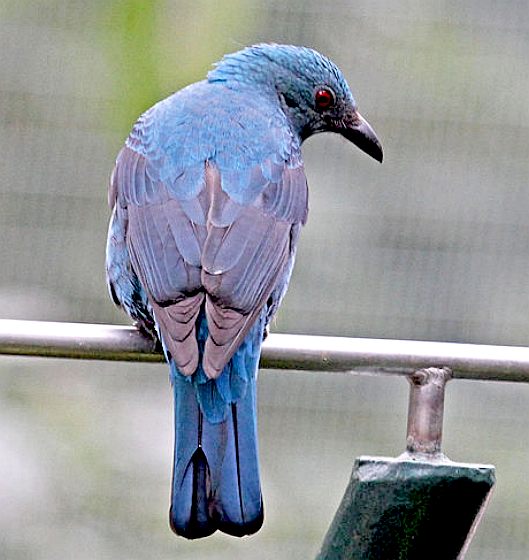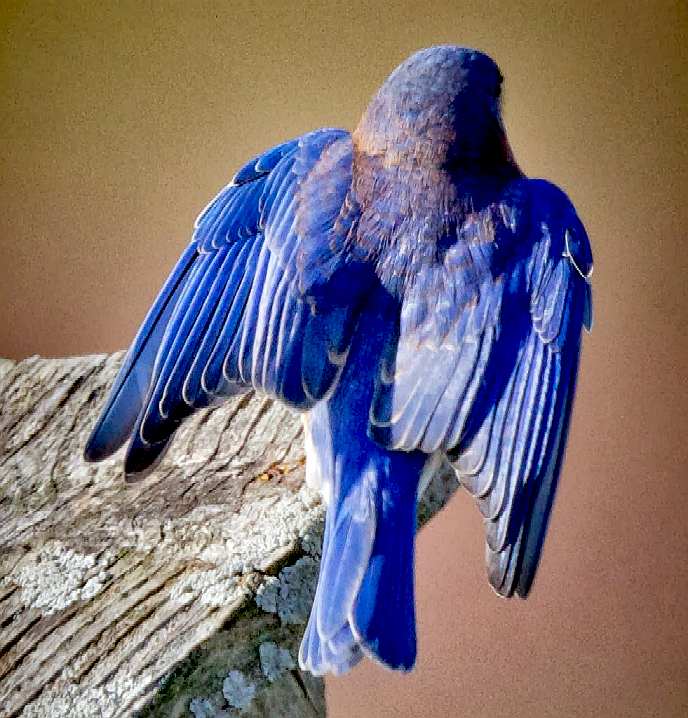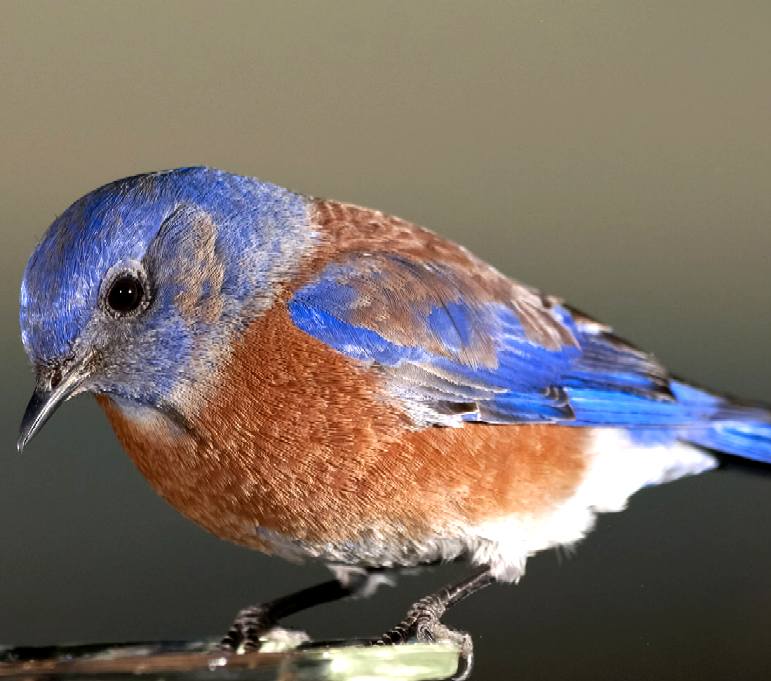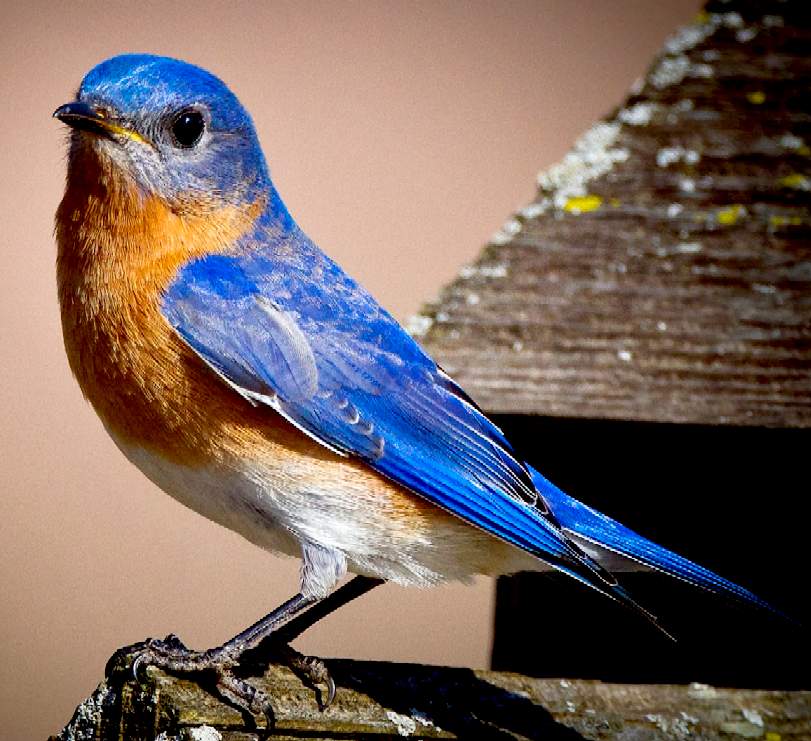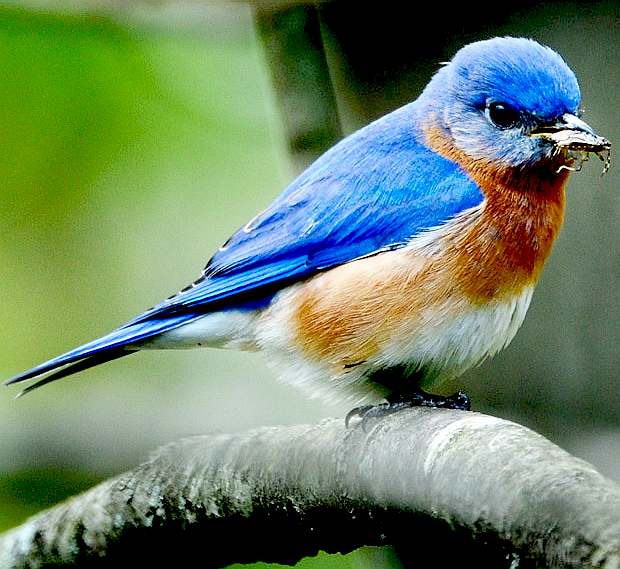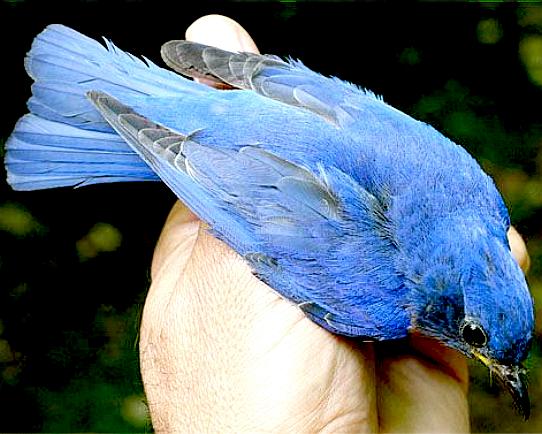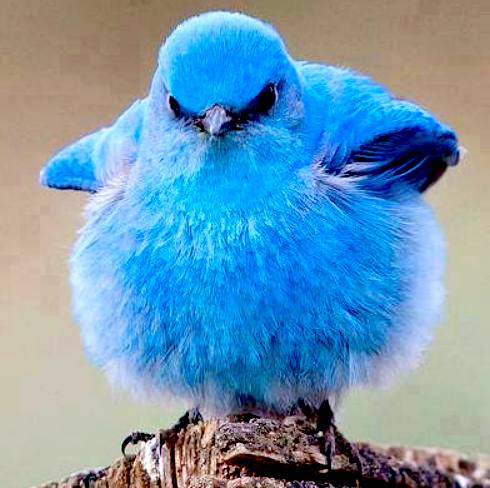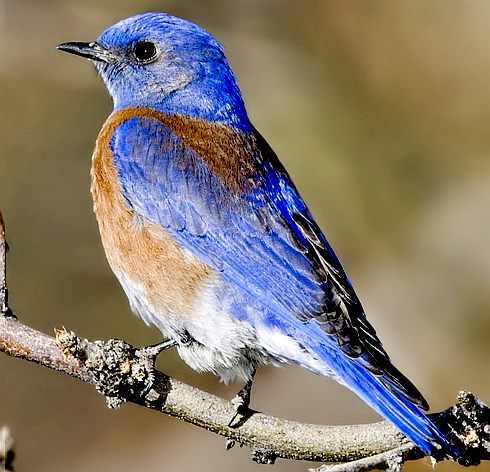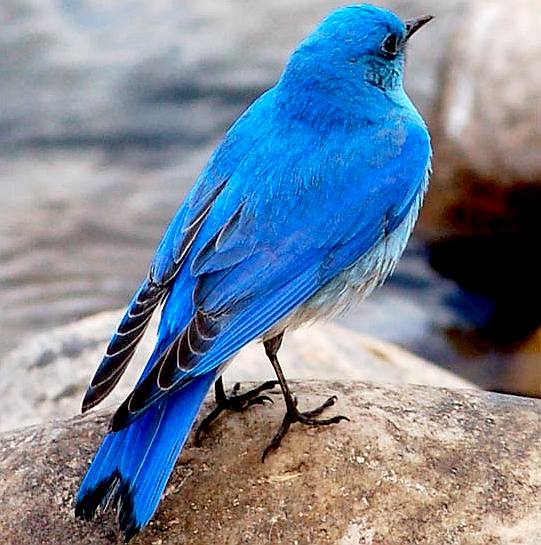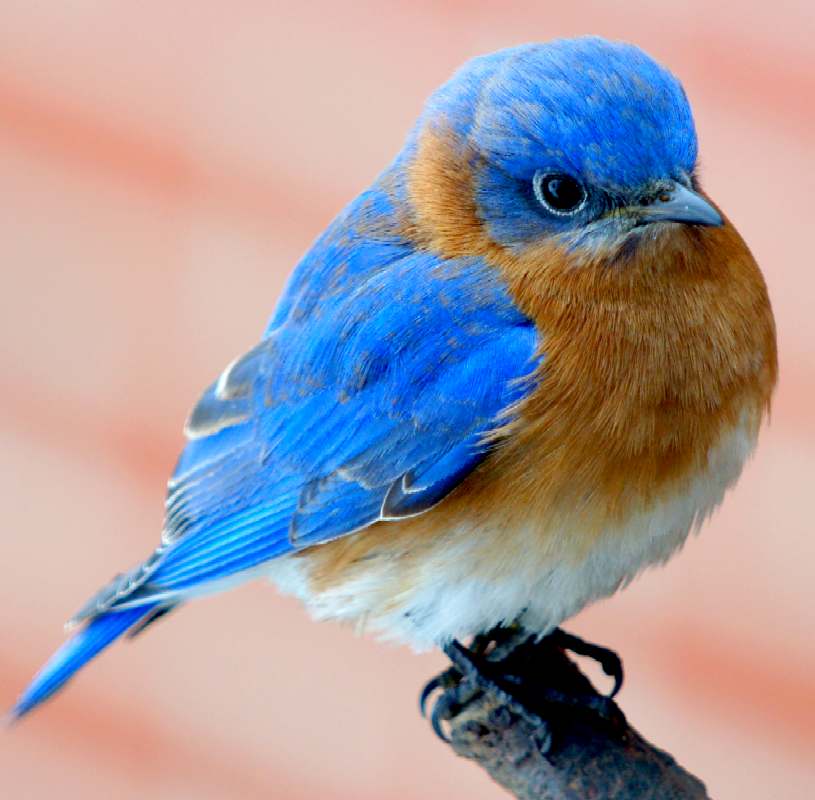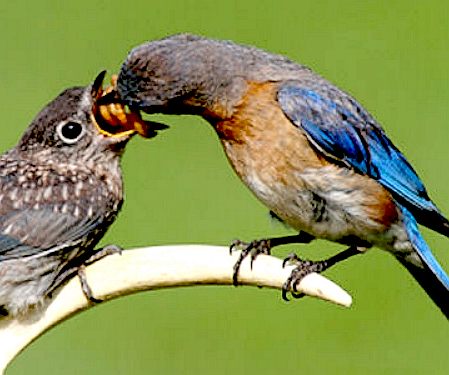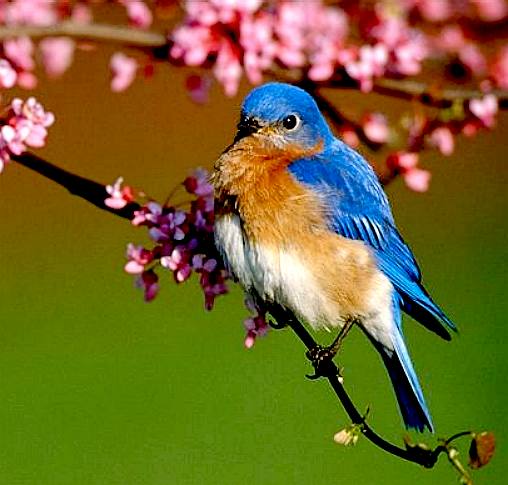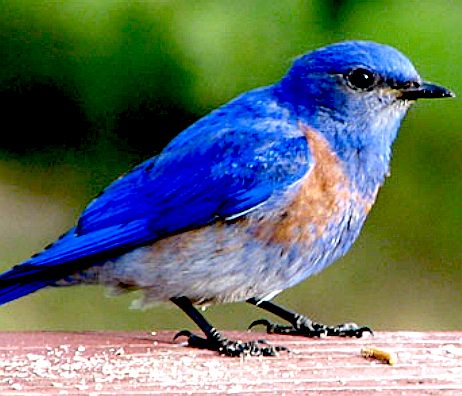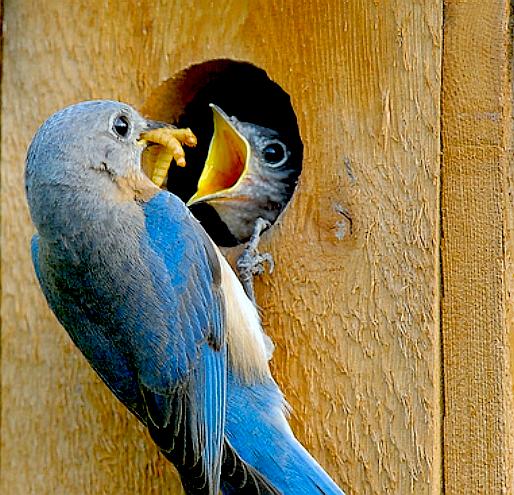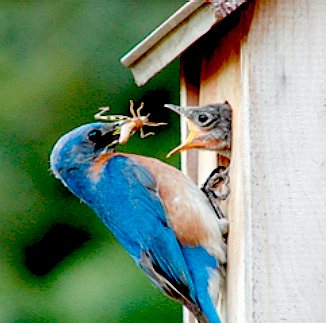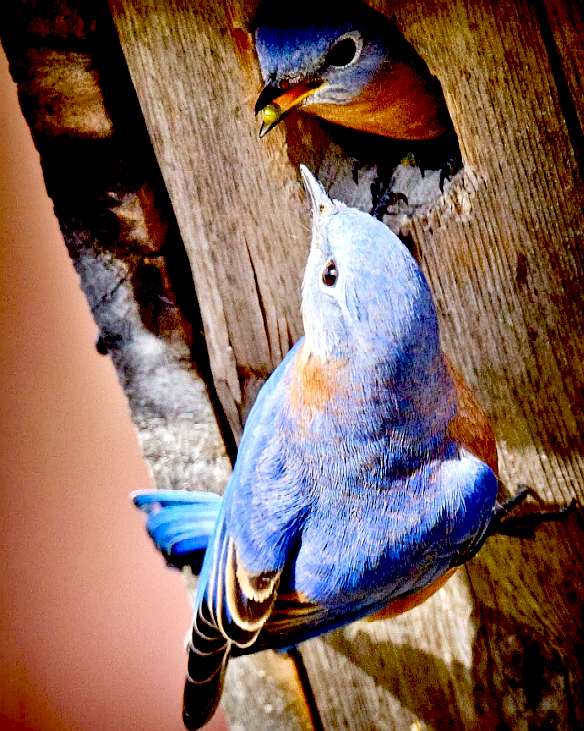|
The
Bluebird is a member of the thrush family related to the American Robin.
The Eastern Bluebird (Sialia sialis) is generally found in the eastern
half of North America to the Rocky Mountains. The Mountain Bluebird (Sialia
currucoides) is found from the eastern foothills of the Rocky Mountains
west to the Pacific coast of North
America. The Western Bluebird (Sialia
mexicana) is typically found west of the Rocky Mountains. All three
species are blue on the back. The Eastern has a red breast and white
belly. The Mountain is slightly larger than the Eastern and does not have
the red breast. The Western is similar to the Eastern with the red of the
breast spreading around to the back. Bluebirds are not 'Bluejays', Indigo
Buntings', or any other species of bird that is blue in colour.
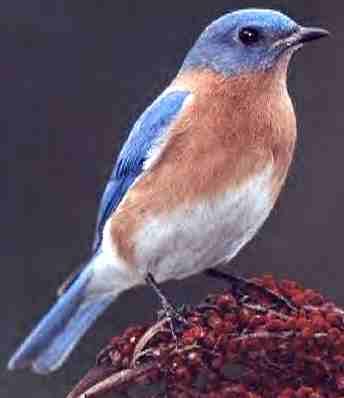
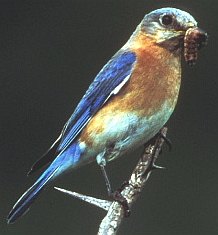
Bluebird
- a member of the Thrush family. Left: Eastern Bluebird
HABITAT
The
natural habitat of Bluebirds are open fields, prairies, and meadows with
few trees or shrubs. The natural nest location is an old woodpecker hole
or rotted (hollow) limb on a tree. The artificial habitat that man has
created that is usable by the Bluebird includes broome fields, horse and
cattle pastures, cemeteries, golf courses etc. This artificial habitat
should be one that does not include the use of pesticides, as they can be
harmful to the insect eating birds. Man has taken up the Bluebird cause
and has created nest boxes for the Bluebirds on both the natural and
artificial habitat areas. Woodland habitat is less favorable to bluebirds,
but there are a number of other species that would make use of a Bluebird
nest box in such habitat. These would include House Wrens, Chickadees,
Great-Crested Flycatcher, Nuthatches, Titmice. Placing a Bluebird box in
woodland habitat is not necessarily bad but, Bluebirds nesting there would
probably be usurped by other birds (most probably house wrens). Where
house wrens or flying squirrels are present in your area then these two
species may take over use of your bluebird nestboxes in mostly wooded
areas. Other wrens are not considered a problem.
Bluebirds are insect eaters and less competitive for nesting space than are other cavity nesters.
Placement of nest boxes should then be in locations away from heavily wooded habitat preferred by tree swallows and house wrens and near open fields where
insect hunting, maneuverability, and visibility to avoid predators is adequate.
Generally, open rural country with scattered clumps of trees or low shrubs is best. Placing boxes too close to shelterbelts and wooded areas will attract house wrens and tree swallows, which are also beneficial bird species. Examples of good habitat include pastures, fields, edges of country roads, cemeteries and golf courses. The closer you get to buildings or urban areas, the more chance you will have problems with house sparrows which will actually kill bluebirds and their young. It is also a good idea to avoid areas where insecticide use is high.
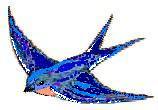
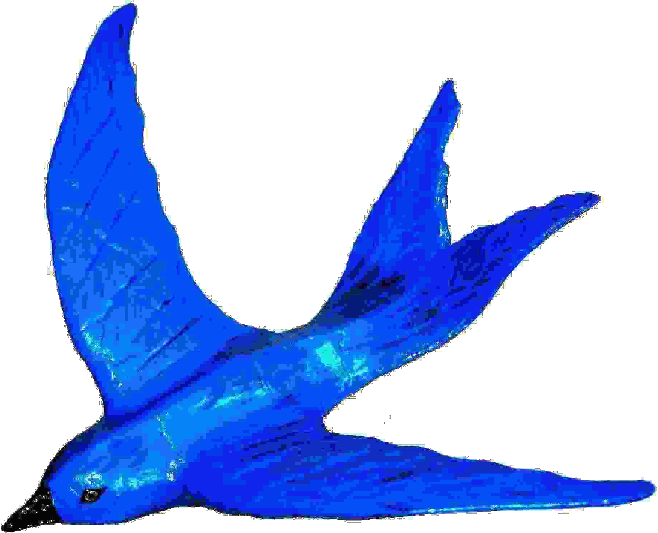
It
would be an understatement to say that the bluebirds of north America and
around the world influenced the design on our registered trademark.
We commissioned a copyright blue bird artwork (sculpture) in
3D which has been photographed in 2D to produce the logos for this site,
embroidery and other uses in connection with the classes that are registered with
the IPO.
Our
'Bluebird' trademark accurately depicts the bird's coloration, twin tail
feathers, beak and head shape. Many songs and poems have been written
about this lively little animal. The Bluebird became immortalized in
Maurice Maeterlinck's
play: 'The Bluebird' which first inspired Malcolm Campbell to adopt the
name for his racing vehicles in the 1930's.
DESCRIPTION
The
bluebirds are medium-sized, mostly insectivorous or omnivorous birds in
the genus Sialia of the thrush family Turdidae.
These are one of the relatively few thrush genera to be restricted to the
Americas. As the name implies, these are attractive birds with blue, or
blue and red, plumage. Female birds are less brightly colored than males,
although color patterns are similar and there is no noticeable difference
in size between sexes.
Species:
Eastern Bluebird, Sialia sialis
Western Bluebird, Sialia mexicana
Mountain Bluebird, Sialia currucoides
BEHAVIOR
Bluebirds are territorial, prefer open grassland with scattered trees and
are cavity nesters (similar to many species of woodpecker). Bluebirds can
typically produce between two to four broods during the spring and summer
(March through August in the Northeastern United States). Males identify
potential nest sites and try to attract prospective female mates to those
nesting sites with special behaviors that include singing and flapping
wings, and then placing some material in a nesting box or cavity. If the
female accepts the male and the nesting site, she alone builds the nest
and incubates the eggs.
Predators of young bluebirds in the nests can include snakes, cats and
raccoons. Non-native bird species competing with bluebirds for nesting
locations include the Common Starling and House Sparrow, both of which
kill adult bluebirds sitting on their nests along with the young and eggs
in order to claim the nesting site.
Bluebirds are attracted to platform bird feeders, filled with grubs of the
darkling beetle, sold by many online bird product wholesalers as
mealworms. Bluebirds will also eat raisins soaked in water. In addition,
in winter bluebirds use backyard heated birdbaths.
By the 1970s, bluebird numbers had declined by estimates ranging to 70%
due to unsuccessful competition with house sparrows and starlings, both
introduced species, for nesting cavities, coupled with a decline in
habitat. However, in late 2005 Cornell University's Lab of Ornithology
reported bluebird sightings at many locations in the southern U.S. as part
of its yearly Backyard Bird Count, a strong indication of the bluebird's
return to the region. This upsurge can largely be attributed to a movement
of volunteers establishing and maintaining bluebird trails.
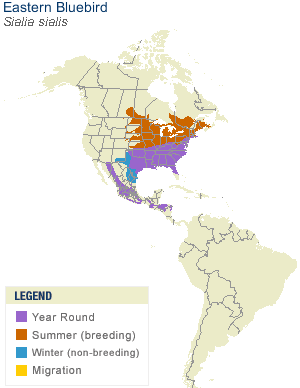
CHOOSING A NEST BOX
The type of box to buy or make to attract bluebirds is a subject of
considerable debate. There are probably as many ideas as there are people who maintain bluebird trails. Ideas come from personal experiences and you will certainly have your own opinion after a few years of monitoring
houses. There are, though, a few basic ideas that have proven successful for producing bluebirds and these guidelines provide a good place to start. North American Bluebird Society approved bluebird houses are always recommended.
Wood is probably the safest and best material for nest boxes. Wood mimics the natural cavity, is readily available, easy to work with and provides good insulation qualities. The best woods to use are cedar or redwood which withstand the elements without being treated.
Choosing between different designs of wooden boxes available shouldn't preoccupy a majority of your time since most offer the same result for the birds. Simply insure floor dimensions are at least four by four inches for eastern bluebirds and five by five inches for mountain bluebirds. Avoid thin
wood which will not maintain tolerable temperatures inside the box. Also, do not use varnishes or stain inside the nesting box. These may be poisonous to the birds.
Both ventilation and drainage holes should accompany any box. One-half inch vent holes in the side of the nesting cavity will insure proper temperatures are maintained inside the nest box. The same sized holes can be drilled into the corners of the floor to allow moisture to escape. Entrance holes for eastern bluebirds should be one and one-half inches in diameter and about one-quarter inch larger for the mountain species. Holes in an oval shape have also been developed now under the presumption that birds can access with less difficulty.
The box should not contain a perch and the roof should overhang the entrance hole to keep rain and sun away. The entrance hole should be about six inches from the floor of the nest box.
One of the most important aspects is that you allow easy access for
monitoring, by hinging either the top, front, or one of the side panels.
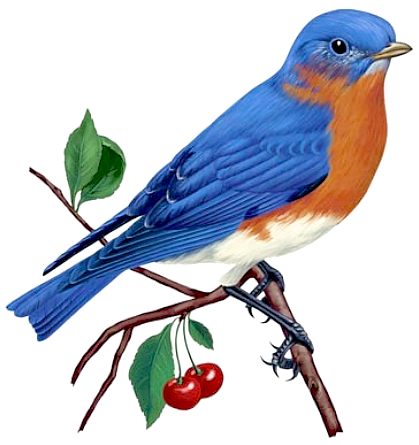
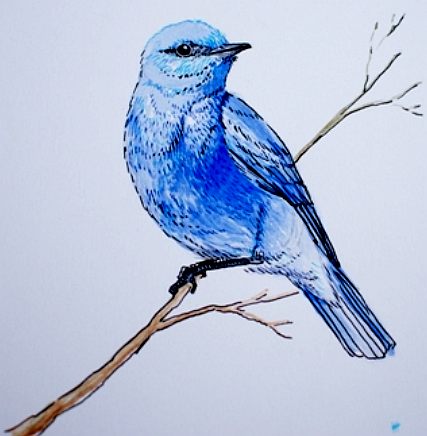
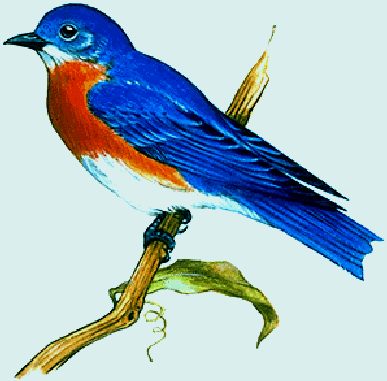
Bluebird
illustrations and paintings
ATTRACTING
BLUEBIRDS - PLACING NEST BOXES
Before you begin putting out any nest boxes, take into consideration the location of preferred habitat. Some locations may not be suitable for
bluebirds
but will be excellent for other beneficial species such as the tree swallow.
A bluebird trail does not have to contain a hundred boxes, it can be comprised of as few as two boxes. The first step is to draw a sketch of your property as you walk it, visualizing potential locations.
Boxes should be located in pairs about 100 yards apart. Ten to twenty feet should be left between boxes in a pair. Pairing the boxes will allow a more aggressive species such as the tree swallow or house wren to nest in one of the boxes first while allowing the second box of the pair for a bluebird. This strategy is all based on bird behavior because many bird species will not allow another member of the same species to nest in close proximity to their own nest but will allow another species like the bluebird to nest.
Nest boxes should be attached to steel posts if possible. Seven foot smooth steel fence posts work extremely well and allow easy attachment. Wooden posts allow predators to climb and access nest boxes more easily. If you do use wooden posts, predator guards can be attached.
Don't attach nest boxes to dead or dying trees within a forested area unless you are attempting to attract house wrens, chickadees, or nuthatches.
The recommended height for bluebird houses is four to six feet from the ground. Bluebirds may nest in higher locations but monitoring, viewing and maintenance will be much more difficult.
Face the front of the nest boxes away from the prevailing wind and in an easterly direction to avoid the hot afternoon sun from shining into the access hole. More important than this, face the box in a direction in which the young fledgling birds can reach a perch within about 100 feet. If you are attaching boxes to existing fence posts within a cattle pasture, put the boxes on the side of the fence opposite that of the cattle so they cannot be broken off by the
cattle.
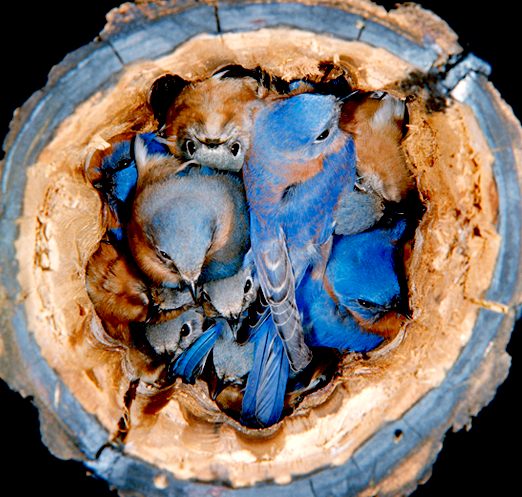
INCUBATION
The male bluebird takes the lead in exploring habitat and attracting a mate but the female is the one who makes final determination of where the nest is built. This process can be swift or it may take weeks. The time utilized in this effort is usually dependent upon the birds experience and whether they had previously nested in that same location.
Females are in charge of all the actual nest
building. At times, the male may carry some nest material but this seems to be a behavior to stimulate the female to nest build and does not amount to much in overall creation of the nest.
A nest normally takes around six days to complete but may be interrupted and begin at a later date. All of this is dependent upon
weather and individual bluebird habits. Pairs normally spend less time building nests for their second or third broods.
During egg laying, the female leaves the eggs unattended and begins incubating after the last or second to the last egg is laid. She is also in charge of incubating the eggs by herself. One reason for this is that she develops a brood patch consisting of an area on her breast where feathers are lost and blood vessels increase. This allows her to keep the eggs at the right temperature for development, a task the male could not perform.
During incubation, the female attends to the eggs almost constantly. Eggs are incubated throughout the night and during the day except when she leaves the nest to preen herself or feed. On hot days, eggs may be left for longer periods of time since they maintain adequate temperatures without her help.
While the female incubating, the male may come by and sing or bring food. It may be a signal that no predators are nearby and that she can safely leave the nest. While she is away, the male will remain close by and may even enter the nest box. At night, the male may sit next to the incubating female.
Incubation for both species is about two weeks but can be affected by weather. In cold springs, incubation can actually take somewhat longer if eggs experience periods of cooling.
BLUEBIRD
GALLERY: BIRDS IN FLIGHT
A
review of some of the more stunning photographs on the internet, taken by
some of the more fortunate amateur and professional bluebird lovers from
around the world - like us.
BLUEBIRD
GALLERY: BIRDS PERCHED
Is
it not wonderful that we can make a box of wood and that the bluebird will
reward us by moving in. That does not distract from the fact that like
nearly all other birds, the bluebird is a devoted parent. How that came to
be hard wired into all animals to some level is amazing - surely a puzzle
for computer programmers to look into.
BLUEBIRDS IN SONG
Bluebirds are featured in several songs. Al Jolson sang of Bluebirds in
"April Showers". But perhaps the artist most associated with the bluebird
is Judy Garland. Her immortal "Over the Rainbow" from the
equally legendary The Wizard of
Oz, proclaimed her belief that "If
happy little bluebirds fly above the rainbow, why oh why can't I". A
few years later in the movie Ziegfeld Girl she admitted in the song
"I'm Always Chasing Rainbows" that she was "waiting to find
a little bluebird in vain." Indeed one of the final songs Garland
sang in a movie was "Hello Bluebird" from I Could Go On Singing.
Also in the 1934 famous Christmas Song "Winter Wonderland" (eg
performed by the Andrew Sisters) the bluebird at least appears as
"being gone", suggesting that this bird is indeed a migrating
one.
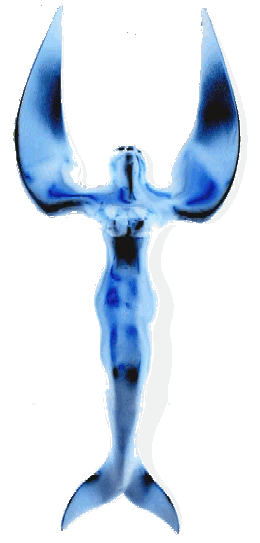
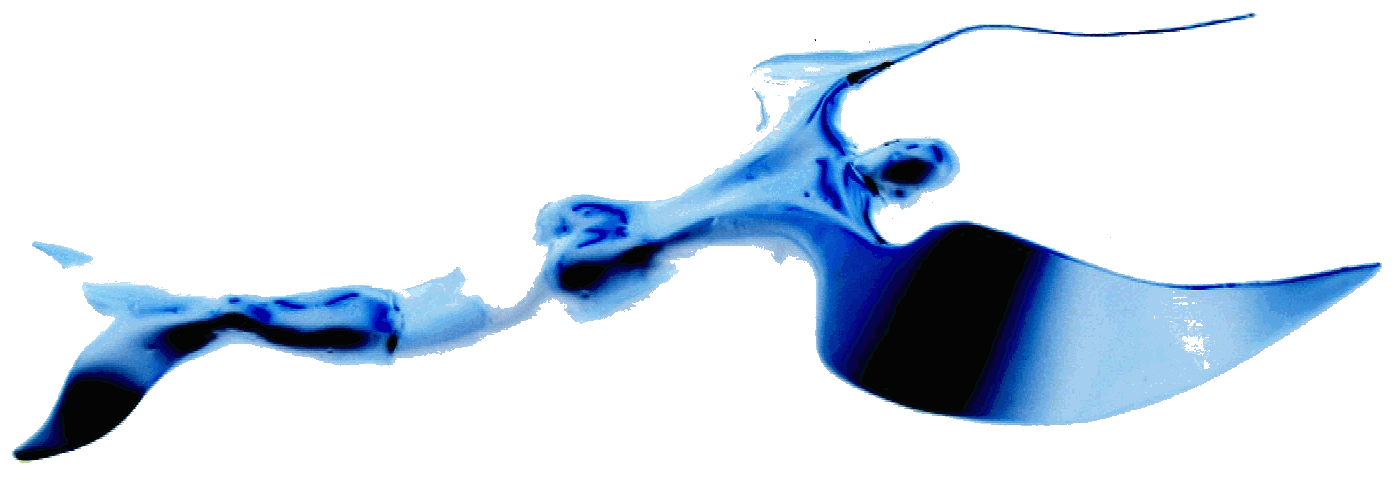
One
of the most stunning sculptures from 2013, the Solar Spirit must surely
qualify as a blue angel. As angels have wings, she flies like a bird. This
art is not only a trademark
but also copyright © 2013 in 2D and 3D, as here asserted by the artist.
The Origins Of The Song
The original song Bluebird of Happiness was introduced at Radio City Music
Hall. Popularized by Jan Peerce in the 1948 best-selling record by
Art Mooney and
his Orchestra. Lyricss by Edward Heyman & Harry Parr Davies,
music by Sandor Harmati.
(verse)
The beggar man and his mighty king are only
diff'rent in name,
For they are treated just the same by fate.
Today a smile and tomorrow tears,
We're never sure what's in store,
So learn your lesson before too late, so
(refrain)
Be like I, hold your head up high,
Till you find a bluebird of happiness.
You will find greater peace of mind
Knowing there's a bluebird of happiness.
And when he sings to you,
Though you're deep in blue,
You will see a ray of light creep through,
And so remember this, life is no abyss,
Somewhere there's a bluebird of happiness.
Life
is sweet, tender and complete
When you find the bluebird of happiness.
You will find perfect peace of mind
When you find the bluebird of happiness.
Two hearts that beat as one,
'Neath a new found sun,
We are in a world that's just begun,
And you must sing his song, as you go along,
When you find the bluebird of happiness.
---------------
BLUEBIRDS
OVER THE WHITE CLIFFS OF DOVER
A
truly great little number, this
is a famous World War Two song by Dame Vera
Lynn, who was also known as the 'Forces Sweetheart'. Dame Vera famously proclaimed that there would
be "Bluebirds Over The White Cliffs Of Dover" in her popular
war-time melody. Hear it a couple of times and you'll be humming the
tune for the
next week.
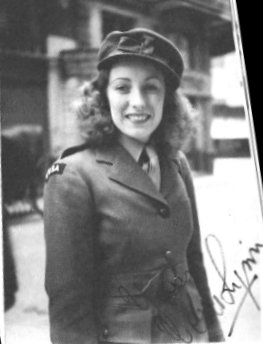
Vera
Lynn - the forces sweetheart
BLUEBIRD
LINKS & REFERENCE
Arlene
Ripley's The Nest Box - Attracting
Eastern Bluebirds by Ed Nied jr
Bluebird
Fancying by Terry Washburn
Phil's
Bluebird Page - Linda
Violett
Birds
in spring, & other bird lover's resources!
Blue
Ridge Mountain Bluebirds
UMBC
BLUEBIRD TRAIL (University of Maryland Baltimore College)
Richard
& Diane Van Vleck - The
Home Habitat
Green
River Cemetery and Bluebird Sanctuary
George
M. Radcliffe Bluebird Monitoring Program
Boyd
Anthony's The Eastern Bluebird
The
Spark in Clarke
Davidson
College - Dr. Mark Stanback
Fawzi
P. Emad - Bluebird
Groups
Joe
Huber's Sparrow Control/Roosting Bluebirds
Bruce
Johnson - Matt's
Eastern Bluebird Page
Christy's
Bluebird Project
American
Family Bluebird Trail Project
Bluebird
Hollow: A Nestbox Trail in New Jersey
The
Benz Bluebirds of Howard County
Wendell
Long - Joanne's
Backyard
University
of Georgia Institute of Ecology P.A. Gowaty Bluebirds
Bluebird
Information & Awareness
Shirl's
Bluebird Acres
Sarah's
Purple Martins & Bluebird Trail
http://www.elizaduck.com/nests.htm
Nest/Egg I
Bluebird
Reference Guide
Terry
Whitworth Blowfly - Wikipedia
Bluebird
All
about birds western_bluebird - Strobist
blogspot bluebirds and stink bugs
All
about birds eastern_bluebird - Bluebirds
National
Geographic
Feather
tailed stories eastern bluebird
Shaw
Creek Bird Supply attracting_bluebirds
How
stuff works bluebird
Virginia
Bluebirds Society - Hilton
Pond this week
Feather
tailed stories blogspot eastern bluebird havens wood state forest
Love
this picture mountain bluebird - Western
bluebird
Community
AARP Bluebird Facts - Bluebird
Pete - Birds
in book
Western
bluebird sialia mexicana enjoying snack
http://www.icannotsleep.net/birds-in-book.html
http://en.wikipedia.org/wiki/Bluebird
http://www.allaboutbirds.org/guide/western_bluebird/id
http://strobist.blogspot.co.uk/2013/04/bluebirds-and-stink-bugs.html
http://www.allaboutbirds.org/guide/eastern_bluebird/id
http://animals.nationalgeographic.com/animals/birds/bluebird/
http://feathertailedstories.blogspot.co.uk/2012/07/eastern-bluebird.html
http://www.shawcreekbirdsupply.com/attracting_bluebirds.htm
http://animals.howstuffworks.com/birds/bluebird-info.htm
http://www.virginiabluebirds.org/
http://www.hiltonpond.org/thisweek050608.html
http://feathertailedstories.blogspot.co.uk/2013/10/eastern-bluebird-havenswood-state-forest.html
http://www.lovethispic.com/image/38368/mountain-bluebird
http://birds.audubon.org/birds/western-bluebird
http://community.aarp.org/t5/For-The-Birds/Bluebird-Facts/m-p/73542
http://bluebirdpete.wordpress.com/
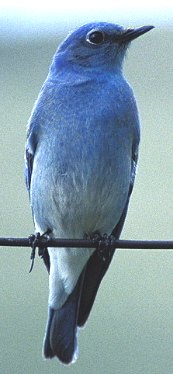
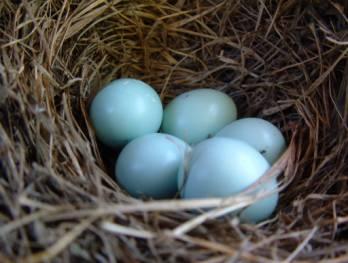
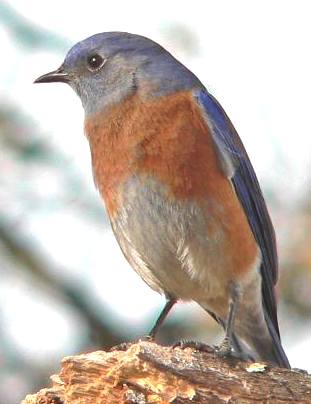
Mountain
and Western Bluebirds and a nest with sky blue eggs
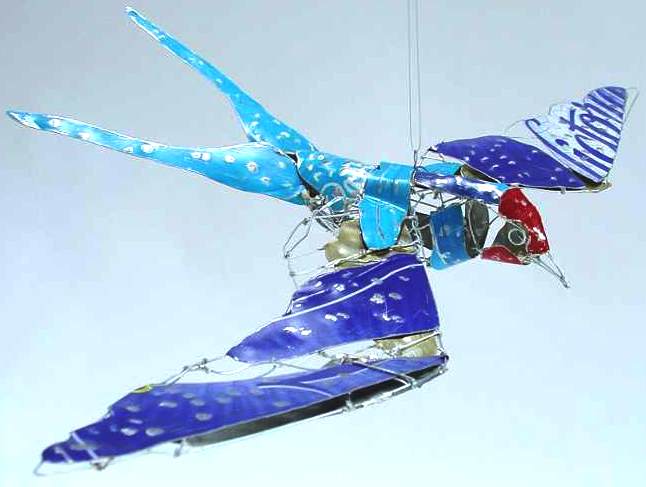
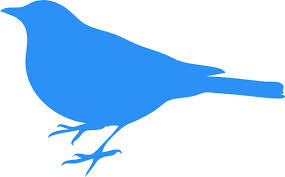
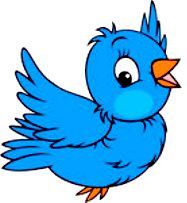
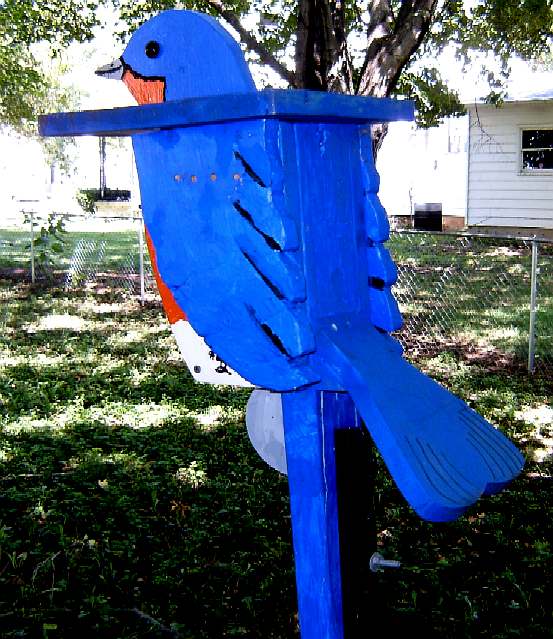
Metal
enameled Bluebird sculpture, clipart and wooden nesting box
SIR
MALCOLM CAMPBELL'S BLUE BIRDS
Sunbeam
- Napier
Lion - Rolls
Royce - K3
- K4
DONALD
CAMPBELL'S BLUEBIRDS - K7
- CN7 - CNM8
|









